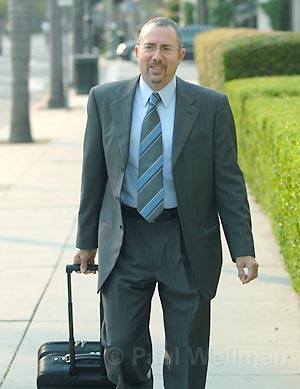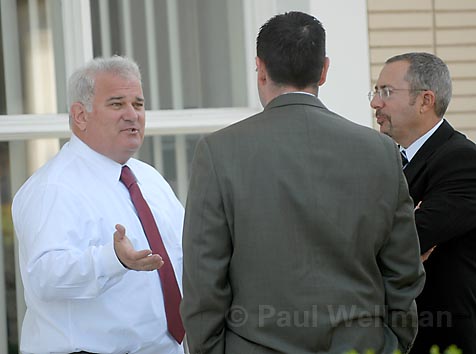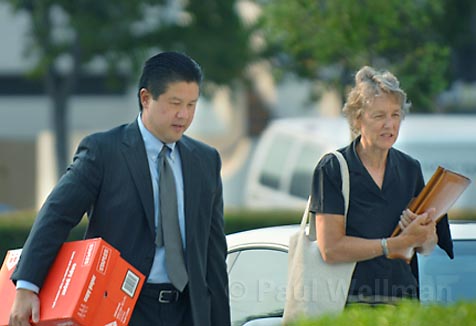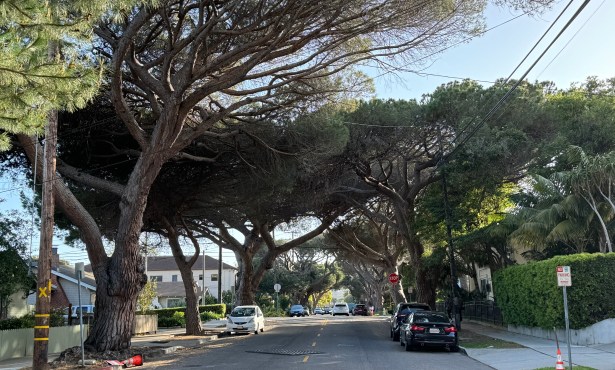Bias Is as Bias Does at the News-Press
Former Editor Linda Strean Testifies and Current Editor Scott Steepleton Continues

There were occasional brushes with excitement in the U.S. Bankruptcy Court on Wednesday as the federal labor law case against the Santa Barbara News-Press entered the second day of proceedings. (See day one round-up here.) The bulk of the day was the continuing and consequential testimony of the paper’s current associate editor Scott Steepleton, the man admittedly responsible for committing the acts – specifically the reprimanding and firing of unionized reporters – that brought the National Labor Relations Board attorneys to town. But the highlight was the testimony – other than the near derailment of the News-Press‘s entire defense – of the paper’s former managing editor Linda Strean, who flew in from Oakland for the afternoon session and shed light on the way the once award-winning, reporter-filled newspaper used to function under Jerry Roberts.
The morning began with Teamster attorney Ira Gottlieb trying to get Steepleton to slip up. Gottlieb, who probably was surprised to see that his gray and pink tie matched Steepleton’s nicely, showed the editor a photo of the overpass protest, had him read the various signs, and had him identify the people involved. That protest is what the union is claiming led to the firing of six reporters. Steepleton has not denied that, but has argued that they were fired for “disloyalty,” and not their union involvement.
Gottlieb then moved onto the termination of Melinda Burns, who Steepleton says was fired for biased reporting. Going through Burns’ performance evaluations, it was clear she scored highly, though there were steady mentions of bias creeping into her reporting. However, the evaluations tempered such statements by saying such was a typical trend for senior reporters who knew their topics well, that she was responsive to suggested changes, and that she was showing an improvement over the years.
Cited as one example in Burns’ termination letter was an article she wrote on the Measure D transportation tax. A lobbying firm pulled a piece from that article, and used it in campaign mailers, which News-Press management believed was evidence of her bias. (Later testimony would explain that such is a common practice by lobbying firms.) Steepleton’s stance was essentially that – despite no further written warnings from management – she had not changed her biases enough by October 2006, so she was fired after 20-plus years of work.
Steepleton’s amount of “do not recalls” dropped substantially when the newspaper’s attorney Barry Cappello (pictured above) started his cross-examination of the editor. Cappello used his time with Steepleton to paint a picture of a changing newsroom, one in which the owner Wendy McCaw would use a heavy hand to shape the news coverage and fire reporters at will to rid the newsroom of bias. And this, Cappello’s line of argument goes, is perfectly fine, because business owners can do what they want with their products.
When asked to recall what Steepleton had said in a meeting with reporters when he took a leadership role, Steepleton replied, “We want nothing but a fair and balanced newspaper.” When worried reporters inquired asked about the day-to-day involvement of McCaw – who had recently tried to kill a story about Travis Armstrong’s DUI and punished employees for publishing Rob Lowe’s address in a planning story, leading to the exodus of the paper’s senior and experienced staff – Steepleton said, “She owns the newspaper, and I think she has every right to be a part of whatever she wants to be a part of.”
The court gallery – which was peppered with scribbling reporters, some public watchers, and Cappello’s crew of young assistants, laptop-using paralegals, and head-high document boxes – then got a rundown of Steepleton’s career. Graduated with journalism degree from Cal State Northridge in 1986. Worked for Ventura County Coast Reporter 1983-1986. Worked in family business for a few years. Started back in journalism in 1990 at Paso Robles’ weekly Country News, where he worked until 1996. He joined the News-Press in 2000 after a stint at the L.A.Times.
Then Steepleton’s testimony trotted along. He told McCaw that the reporters “wanted to do what they wanted to do when they wanted to do it” and that she “would not tolerate it.” He covered July 6, 2006, the day that Jerry Roberts left along with most of the management and senior staff. He described the newsroom “reorganization” and the performance review process and how, under new management, Steepleton himself would run all of the evaluations rather than leave it up to assistant editors. (No mention was made of the dwindling management staff.)

When Cappello tried to delve into the Rob Lowe incident to explore the notion of bias, NLRB attorney Steve Wyllie objected to the line of inquiry, saying that it wasn’t an example of bias, and that it really had nothing to do with the charges. Judge William Kocol was also confused as to the relevance. A visibly flustered Cappello – who slides easily in court from being humorously obsequious to being a bully – accused the judge of “being narrow.”
Wyllie argued that the Lowe incident had nothing to do with this case, and that “editorial content and control” was something that Cappello was trying to turn the case into. Cappello was trying to assert that the reason for the employees forming a union – that they wanted to keep owner Wendy McCaw out of the newsroom, not seek higher wages or better benefits – was an integral part of this case, and the heart of his defense. Wyllie countered that the impetus of the union had nothing to do with the case. Rather, said Wyllie, this was about illegally firing and mistreating employees because they were involved in a union.
Judge Kocol at first sided with Wyllie, sustaining an objection, and potentially derailing Cappello’s main tactic. But then more debate ensued, and Kocol asked Cappello if he was trying to say that, due to their untraditional demands, that they were not protected as a union. Cappello confirmed that and also said that he would only pursue this sort of testimony related to the Lowe and Travis Armstrong DUI incidents. Kocol allowed the testimony to continue, overruling a Wyllie objection.
It seemed that Kocol was a bit handcuffed by the situation, and decided it was in his best interest to hear Cappello out, even if the relevance between the union’s impetus and the charges of illegal firings was not yet clear. That distinction will likely prove crucial, for it seems to be Cappello’s central argument.
Starshine Roshell, who the union claims had her column killed because of her campaigning, then became a focus. Her letters following the July 6, 2006 walk-out were shown on a video screen. She had been reassigned from feature writing to the news department, and her column had been killed, along with every other column in the newspaper. (According to Steepleton’s testimony over the past two days, McCaw felt that killing columns by staffers was a way to root bias out of the paper. However, since all of the freelance columnists were also terminated, former employees believe it was really just retaliation against everyone from the Jerry Roberts regime.)

Starshine’s first letter said her new assigmment “sounds like fun,” though the irony of the clearly satirical statement seemed to be lost on Steepleton and Cappello (or they just ignored it). Later letters requested to take her freelance column to the freelance world, which she signed with a smiley face. After Steepleton denied her request, she wrote that she’d gotten permission from attorney Ira Gottlieb to publish her columns elsewhere. Steepleton called the letter “outrageous.” In her final letter, a resignation, there was “no smiley face this time,” said Cappello, and it was filled with “invectives.” Steepleton said that when she left, she told him, “Fuck you too.”
Before lunch, Steepleton then detailed the biases of Melinda Burns and Anna Davison while admitting that he did not conduct any counseling or disciplinary action before firing them. Their biases, said Steepleton in his termination letters and testimony, centered on two main articles. For Burns, it was the Measure D piece. For Davison, it was the piece on the State Street beautification project, in which she didn’t get a quotation from anyone berating the tree removal.
Steepleton confirmed that both Measure D and the State Street tree removal were vehemently attacked by the News-Press editorial page, and the paper’s management wanted, at the very least, their stance published as part of the articles. The editor also said that reporters everywhere are supposed to be well aware of the editorial stances taken by their employing newspapers. “That’s one of those journalism 101 things,” said Steepleton.
Strean-ing to Melinda’s Rescue
After the lunchbreak, Cappello agreed to let a witness who had flown in from the Bay Area testify. It was Linda Strean, the former managing editor of the News-Press from June 2003 to March 2005 who now works for GreatSchools.net. A journalism veteran, Strean has worked since the late 1970s as a newspaper reporter and editor at multiple newspapers, including prestigious management roles at both the Chronicle and Examiner in San Francisco and a lecturing job at UC-Berkeley’s Graduate School of Journalism.
Questioned by NLRB attorney Brian Gee, Strean was used primarily to vindicate the tenure of Melinda Burns, provide a better understanding of how controlling bias is a primary responsibility for editors and reporters at newspapers everywhere, and show how the News-Press functioned when it had a large and experienced staff under editor Jerry Roberts.

Strean’s categorization of Burns was glowing, even with her admission that Burns’ passionate politics occasionally entered drafts of her articles. When that did happen, Strean or one of the other editors would send it back to Burns, and Burns would “always” fix it. Regarding Burns’ performance evaluations that mentioned bias as a continual issue, Strean said that those mentions did not warrant discharge or even a verbal reprimand. When Judge Kocol wanted to know why not, Strean said that “with Melinda, it was not a consistent problem:When we asked for it to be addressed, she was very good” about fixing her biases. Later in her testimony, Strean summed up Burns by saying, “She’s one of the finest reporters I’ve ever worked with.”
Gee wanted to know whether the bias problem at the News-Press was, in Strean’s experience, a drastic problem. She replied, “It was not more common that at any newspaper I worked for:.I didn’t feel it was a common problem.”
To compare the methods used by Steepleton and current News-Press management to fire Burns and Anna Davison, he used two examples from Strean’s time in Santa Barbara. In both cases, the reporters were having problems with accuracy. In both cases, there was a long paper trail of written warnings that increased in seriousness when the problems were not fixed. This method of progressive discipline was something championed by former editor Jerry Roberts and used throughout Strean’s time at the paper.
When Cappello’s time came to take on Strean, he attacked her credibility. In short, she was a longtime personal and professional friend of Jerry Roberts; Roberts was involved in litigation against News-Press owner Wendy McCaw; and Strean would do anything for Roberts, such as, Cappello’s insinuation goes, testify in a court of law in his favor – or the favor of his colleagues – regardless of the truth. Objections were raised, but not before Cappello could ask, “If you were voting on it, you’d vote for Jerry, right?” Strean was not required to answer.
Cappello’s questioning then got more mundane, as he focused on the part of the employee handbook that said News-Press employees were “at-will” employees and could be fired at any time for any reason. Strean agreed.
By day’s end, Steepleton was back on the stand, and will be again tomorrow morning, August 16, at the Santa Barbara College of Law, 9 a.m. Melinda Burns is also expected to take the stand sometime tomorrow.



